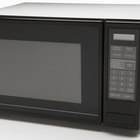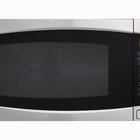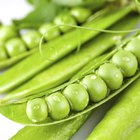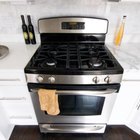
Over 90 percent of Americans have microwaves, according to the University of Arizona, but most of us use them primarily for reheating leftovers. Busy moms can take advantage of these useful appliances for other reasons. Microwaves are very efficient at cooking raw foods, such as fruits and vegetables, and because they cook more quickly than conventional methods, fewer nutrients are lost. Most of the principles that apply to heating leftovers pertain to heating raw foods, as well. Cook on medium heat and check the food frequently to avoid overcooking it.
Food Preparation
Always wash raw vegetables and fruit before placing them in a microwave. Carve large cuts of meat into smaller pieces to promote even, uniform cooking, and prick potatoes to release air that builds up during heating. Scramble eggs before placing them in a microwave-safe bowl coated with non-stick oil spray.
Containers
When microwaving raw foods, use glass, ceramic or plastic containers labeled safe for microwave-use. Containers meant for one-time use, such as margarine or yogurt tubs, are not safe for use in the microwave. They may melt, causing burns or contaminating foods. Cover containers with microwave-safe paper towels, plastic wraps or lids to prevent splatters and burns. With any type of covering, allow for steam to vent. Appropriate microwave lids are vented. The U.S. Department of Agriculture says that if you use plastic wrap, don't allow it to come in contact with the food, and turn a corner back for venting. With the exception of eggs, most raw foods benefit from a small amount of liquid in the container. Add water, chicken broth or vegetable stock to a bowl containing vegetables or meat. Cover and cook. The liquid steams the food, destroying any bacteria and decreasing cooking time. The liquid also keeps the food from drying out.
Placement
Food in a microwave cooks from the outside toward the center, potentially resulting in dry spots or uncooked areas. To minimize this problem, spread the raw food in an even layer in the container. Set larger pieces of food at the outside and smaller pieces in the middle. Use a turntable to rotate the food, and stir it periodically during cooking.
Safety
Read your microwave manual for information on wattage, and for recommended cooking times and temperatures for specific raw foods. When cooking meats, use a thermometer to check that the meat is thoroughly cooked. Cook beef roasts and steaks to an internal temperature of 145 degrees Fahrenheit; pork to 160. Cook poultry and ground meat to at least 165. Because microwaves can cook unevenly, check the temperature in multiple locations. Use pot holders when removing containers from the microwave and lift the lid away from you to release remaining steam safely.
Related Articles

Can You Cook Something Frozen in the ...

The Safety of Refrigerators and ...

How to Convert Stovetop Recipes to ...

Do You Thaw Hamburger Patties Before ...

How to Use a Probe Cooking Thermometer

How Long Does Foil Keep Food Warm?

How to Heat Frozen Meatballs

Heating Foods in Plastic & BPA

How to Reheat Lasagna

How to Cook With a Gas Fireplace
How Long Can Leftovers Be Refrigerated?

How to Store Dehydrated Foods

What Are the Best Containers to Freeze ...

The Positive Effects of Using a ...

Bagel Bites Heating Instructions

How to Use an Indoor Electric Grill

How to Make Ice Cream Thaw Fast

How to Kill Lice on Clothes With the ...

How Long Can Frozen Food Sit Out Before ...

Does Canned Soup Go Bad?
References
Writer Bio
Julie Christensen is a food writer, caterer, and mom-chef. She's the creator of MarmaladeMom.org, dedicated to family fun and delicious food, and released a book titled "More Than Pot Roast: Fast, Fresh Slow Cooker Recipes."
Photo Credits
Jupiterimages/Photos.com/Getty Images